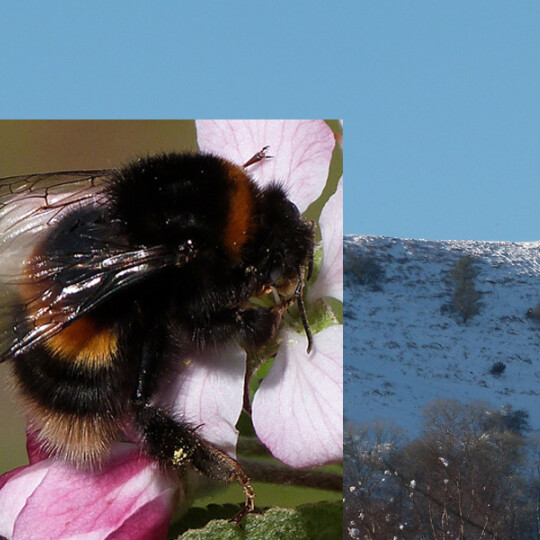For most bumblebees winter is a time for hibernation but for one species it can be just as busy a time as the rest of the year.
Since the 1990s, & almost exclusively in urban areas, Buff tail bumblebees have been observed foraging for pollen in December & January. Whilst warmer, sunny days are more usual for bumblebee activity, due to the lack of flowers in winter they have been recorded on damp, overcast days & even when there is snow on the ground.. (Please note the image is for illustration only - there are no giant bees in the black mountains!)
It is thought that some of the summer generation of queens establish nests in October, with workers appearing from mid-November. These workers may then forage through the winter, with a new generation of queens and males emerging in February.
Where to see winter bees
Key sites are town & city gardens, parks and amenity shrubberies. In urban areas, the temperature is a little higher than the countryside. Garden centres can provide important habitat too.
If you live in England or Wales (especially the south) you might expect to see some bumblebees this winter. Records from north of Leicester & Birmingham are unusual.
Reporting your observations: Take photos wherever possible. Note the location, (latitude & longitude can be helpful) the weather and any other information. Send your recordings to: The Bees, Wasps & Ants Recording Society: http://www.bwars.com/
What can you grow to help winter bees?
You can help by planting autumn & winter flowering plants species.
Mahonia (Oregon Grape) appears to be the favourite, with observations noting 75% of visits were to this spiky leaved plant.
Other autumn & winter flowering species are:
Aconite,
Primrose,
Willow,
Verbena,
Penstemon,
Ice Plant,
Larkspur,
Cone flower,
Michaelmas Daisy,
Golden rod,
Perennial Sunflower (Helianthus),
Red Valerian,
Winter-flowering Honeysuckle,
Winter flowering heathers,
Winter flowering Clematis,

